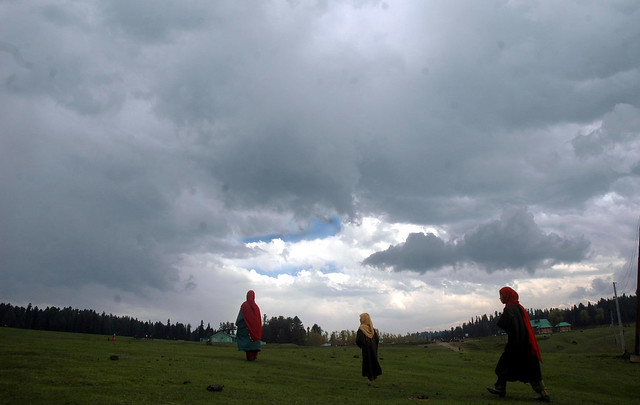By Soroor Ahmed, TwoCircles.net
While most part of the eastern and north-eastern states of India, which witness annual rainfall between 1,300 mm and 2,800 mm have been passing through second year of drought or delayed monsoon, the north and western states, with annual rainfall of between 600 and 900 mm are facing deluge. The two deserts in Rajasthan and Ladakh are flooded by unprecedented downpour while the eastern states are waiting for the aid package from the Centre to fight a prolonged spell of dry weather which had forced farmers at many places, especially in Bihar and Jharkhand, to abandon paddy and go for maize production.

Kashmiri girls under a monsoon sky. [Photo by Shahid Tantray, AIP]
The granary of India––Punjab, Haryana and West Uttar Pradesh––are literally neck-deep in the troubled water. Along with Delhi, which is to hold the Commonwealth Games, they are not prepared to face so much of water from above. Two months of monsoon rain is normally sufficient. Farmers in this region rely mostly on the irrigation network, thanks to a number of Himalayan rivers and chains of canals. So with a number of snow-fed rivers and underground table not too deep farmers seldom face shortage of water even with less annual rainfall.
The eastern Indian states of Assam, West Bengal and Bihar, are among the earliest to confront the monsoon wind from the south. The monsoon is a bit long and they face the problem of over- irrigation. True like the north-western states they too have snow-fed rivers but the annual rainfall is two or three times more. Besides, the landscape is such that the rivers too causes more flood.
As Mount Everest, the loftiest peak in the world, is situated north of Bihar, across Nepal, rivers emanating from this highland have a very steep slope wreaking more havoc than those of Punjab, Haryana and west UP. There are more cases of rivers changing their courses in this part of India than elsewhere. The towering Kanchenjunga lies further east. So the entire stretch of land, especially from Kosi in Bihar to Brahmaputra in Assam, witnesses more devastating floods than anywhere in India.
The problem of excessive rainfall and dreadful rivers often leave behind a trail of death, destruction and chaos. But all these seem to have been changing as in the last two years the eastern region has seen much less rainfall and flooding. This was preceded by two years of unprecedented flooding in 2007 and 2008.
So if with better electricity supply, high yielding variety of seeeds and modernized farming a Green Revolution was possible in Punjab, Haryana and West Uttar Pradesh the eastern region needs a long-term planning as excessive waterlogging in the plains are destroying the foodgrains production forcing the farmers and labourers to migrate. The rampant construction of highways and railways without proper drainage facility in the last few decades have turned a vast area into veritable lakes and swampy land.
Imitating the planters of Assam and North Bengal many farmers of highland area of Kishanganj in Bihar are opting for tea plantation in rest of the plain region of the state as well as Jharkhand and part of West Bengal they are switching over to maize production, especially in the drought years. As maize is considered as a better alternative cash crop than jute, which is grown in the region, more and more farmers are going for it. Maize in this part of the country is both kharif and rabi crop. Productivity of maize in Bihar is 2,541 kg/ha, which is greater than the national average of 1,907 kg/ha. However, in the last rabi (winter) season a couple of cases of suicide by farmers was reported because a prolong spell of fog in January destroyed the kernel. Farmers, who borrowed loan for its production, were left with no option but to take pesticide.
Be it drought or flood or excessive cold farmers of the east not only get less media coverage but also little governmental attention as unlike their counterparts in the north-west they are not feeding the entire country. While those in the north-west may be confronting nature’s onslaught occasionally their counterparts in the east are destined to face it every year.
